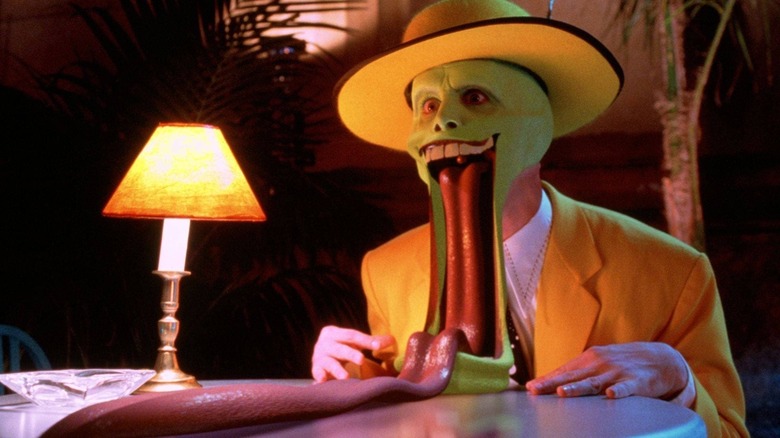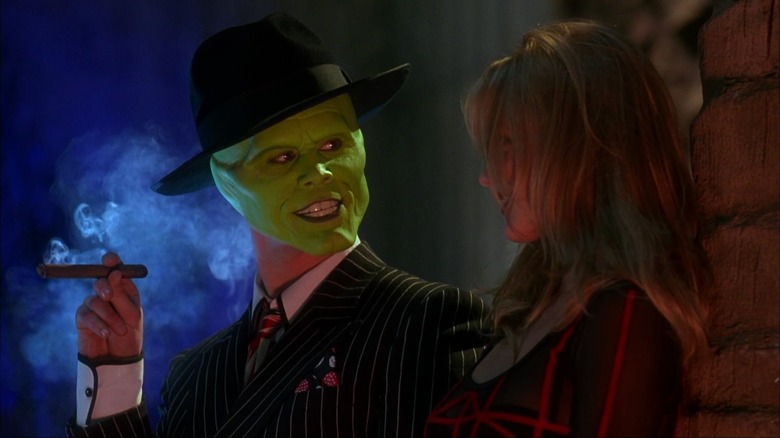New Line Cinema
“The Mask”, a supernatural comedy directed by Chuck Russell in 1994, originated from a character in Dark Horse Comics in 1987 that was known for its ultra-violence. The comic book character, gifted with supernatural abilities through a magic mask, had a grotesque appearance with a gigantic, green-skinned head and grave-like teeth. This mask, however, stripped the wearer of their inhibitions and morality, turning them into deranged, invincible jesters. The comic book version of the Mask can be best described as a violent antihero, more closely associated with horror than conventional superheroism.
The cinematic version of this character, brought to life by Russell, was a toned-down version. The film, rated PG-13, featured a timid, feeble Stanley Ipkiss (portrayed by Jim Carrey) who underwent a transformation into an assertive, flirtatious, and audacious cartoon character after wearing the enchanted mask. Despite committing acts of violence (he was particularly harsh to two mechanics who cheated him), Stanley learns to be a more assertive, sociable person, and eventually becomes somewhat of a crime-fighter. Only those who were already evil continued to be evil under the influence of the mask. “The Mask” was a comedy hit, grossing over $350 million on an $18 million budget, and catapulted Jim Carrey to the Hollywood A-list.
However, during the early stages of the film’s production, “The Mask” leaned heavily towards the frightening tone of the comics. Russell, already having experience in horror filmmaking with films like “A Nightmare on Elm Street 3: Dream Warriors” in 1987 and the remake of “The Blob” in 1988, was ready to make a much bloodier version of “The Mask” for New Line Cinema. In a recent interview with Variety, Russell shared that the movie’s horror and violence were reduced in subsequent drafts because the main character bore too much resemblance to Freddy Krueger.
Chuck Russell’s Revelation about The Mask’s Similarity to Freddy Krueger

New Line Cinema
Russell also revealed that he had to modify the movie upon discovering Jim Carrey. He reminisced about the inception of the project, saying:
“I’d directed ‘A Nightmare on Elm Street 3’ and made friends at New Line. Then I did ‘The Blob’ and New Line wanted another shocking horror film. There was a comic book of ‘The Mask’ that was quite terrifying. I said it’s going to be too much like Freddy Krueger. It’s going to be horrible. But there’s this guy named Jim Carrey who has just come out in ‘In Living Color.'”
“In Living Color”, as some may remember, was a hit sketch comedy series created by Keenan Ivory Wayans that premiered on Fox in 1990. Carrey was part of the original cast and had garnered much praise and recognition. As a comedian, Carrey was known for his extreme physicality, contorting his body and face in new and inventive ways. Russell knew that with such a flexible actor, he would have to change direction with “The Mask”. It would be more beneficial to fully utilize Carrey’s talents. This resulted in the main character transitioning from a sarcastic, violent killer to a wild cartoon man. Russell continued:
“It was the only time in my career when it was very hard to explain to others what was the potential with this particular actor. […] He was a one-man inspiration. I got the script to the point where it lived and breathed Jim Carrey.”
The final script, credited to Mike Werb, had more of a Tex Avery cartoon vibe than “A Nightmare on Elm Street”. Carrey’s signature body and facial contortions gave birth to a new type of film character. It was the right decision.
Chuck Russell’s Indie Spirit in Making ‘The Mask’

New Line Cinema
In 1994, Carrey was not yet a household name, and his co-star, Cameron Diaz, was making her big screen debut. Therefore, Russell was not given a large budget to work with. The only area where Russell was allowed to splurge was the film’s comprehensive digital effects, which Russell was not particularly fond of. As a result, he strived to make the rest of the film appear as realistic as possible. He shot on actual locations for all scenes except one. Russell noted:
“I embraced the concept of an independent, low-budget film. Everything in ‘The Mask’ is a normal location. The only stage set in the entire movie was a small bedroom because I had to trash it. […] It was the joy of independent films and the spirit of a team that’s us against the world. We’re going to make a movie at a certain budget and put all the money on the screen.”
Russell pointed out that because “The Mask” was a relatively low-budget project, the digital effects company, Industrial Light and Magic, could only afford to assign their “worst team” to work on it. However, it seems that even the “worst team” was producing top-notch work. Russell amusingly recalls the visits he received on set from some of ILM’s higher-ups. Everyone seemed impressed. “The Mask” was eventually nominated for Best Special Effects at the Academy Awards, but lost to “Forrest Gump”.
Russell pointed out that his film was so successful that it changed how the Dark Horse comics were illustrated. The character in the comics was drawn to more closely mimic Jim Carrey. However, the books remained remarkably violent.
FAQ
Q: Who directed ‘The Mask’?
A: ‘The Mask’ was directed by Chuck Russell.
Q: Who was the lead actor in ‘The Mask’?
A: The lead actor in ‘The Mask’ was Jim Carrey.
Q: Was ‘The Mask’ originally a horror movie?
A: While the original comic book character had a more horror-oriented tone, the film version directed by Chuck Russell was a supernatural comedy.
Q: What was the budget for ‘The Mask’?
A: The budget for ‘The Mask’ was $18 million.
Q: How much did ‘The Mask’ gross at the box office?
A: ‘The Mask’ grossed over $350 million at the box office.
Credit: www.slashfilm.com


